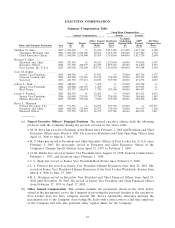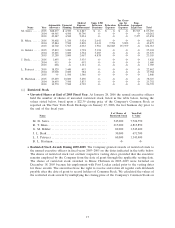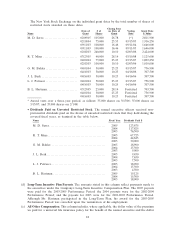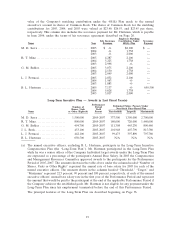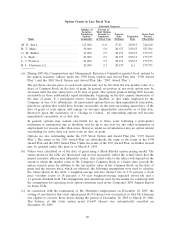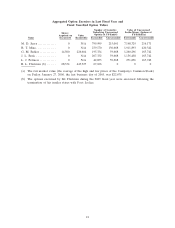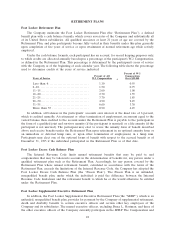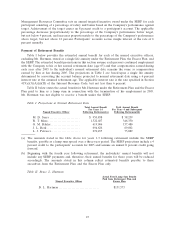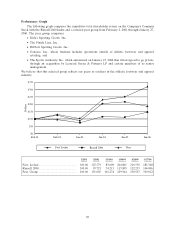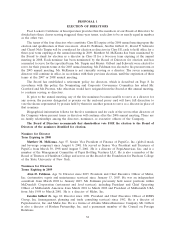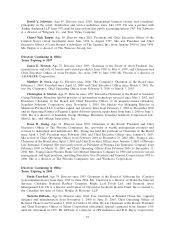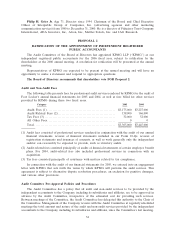Foot Locker 2005 Annual Report Download - page 118
Download and view the complete annual report
Please find page 118 of the 2005 Foot Locker annual report below. You can navigate through the pages in the report by either clicking on the pages listed below, or by using the keyword search tool below to find specific information within the annual report.her annual bonus at target multiplied by the executive’s years of service, with a minimum
severance benefit of 52 weeks’ salary.
Change in Control. If the employment of any of the executives is terminated by him or her for
Good Reason or by the Company without Cause within 24 months following a Change in
Control, then the executive would be entitled to a severance benefit calculated using the same
formula described in the preceding paragraph, except that the minimum severance benefit would
be 104 weeks’ salary plus two times the executive’s annual bonus at target. In addition, all
unvested shares of restricted stock and stock options would vest.
If payments or benefits received by any of the executives under these circumstances are subject
to the excise tax imposed by Section 4999 of the Internal Revenue Code, then we would
automatically reduce his or her payments and benefits to an amount equal to $1 less than the
amount that would subject the executive to the excise tax, provided that this reduced amount
would result in a greater benefit to the executive compared to the unreduced amount on a net
after-tax basis.
•Continuation of Benefits. The executives would be eligible to continue to participate during their
severance periods in any group medical, dental or life insurance plan he or she participated in prior to
termination under substantially the same terms as an active employee. This extended participation
would continue for 52 weeks or, following a change in control, for 104 weeks, unless the executive
becomes eligible for a future employer’s plans or violates the post-employment non-compete and
confidentiality provisions before the end of the severance period.
•Non-Competition. Mr. Mina is subject to a non-competition and non-solicitation provision for two
years following the termination of his employment, and each of the other executives is subject to a
one-year non-competition and non-solicitation provision.
B. L. Hartman
We had an employment agreement with Mr. Hartman as Executive Vice President and Chief
Financial Officer in the same form as the agreements described above for the named executive officers
other than Mr. Serra. Mr. Hartman’s service as Executive Vice President and Chief Financial Officer of
the Company ended at the close of business on November 18, 2005. On December 21, 2005, the
Company and Mr. Hartman entered into a letter agreement (the “Letter Agreement’’) regarding his
resignation, and the termination of his employment effective December 18, 2005 (the “Termination
Date’’). The Letter Agreement provided for:
•a severance payment of $650,500 to Mr. Hartman payable in June 2006, which reflects the
amount of severance provided for under his Employment Agreement;
•a non-competition period, including a prohibition on hiring employees of the Company, for one
year following the Termination Date;
•the accelerated vesting of stock options covering a total of 32,334 shares at exercise prices
ranging from $10.245 to $28.155, which were scheduled to vest in March and April 2006;
•continuation of participation in certain benefit programs for one year following his employment
termination date, including the medical, drug, dental, and life insurance programs for active
employees of the Company, the executive medical reimbursement program, the executive
financial planning program, the automobile expense reimbursement program, and the executive
life insurance program;
•a General Release from Mr. Hartman to the Company; and
•the forfeiture of all unvested shares of restricted stock previously granted to Mr. Hartman.
Mr. Hartman was not eligible to receive bonus payments under the Annual Plan for 2005 or under the
Long-Term Plan for any performance period ending after his termination date.
26


